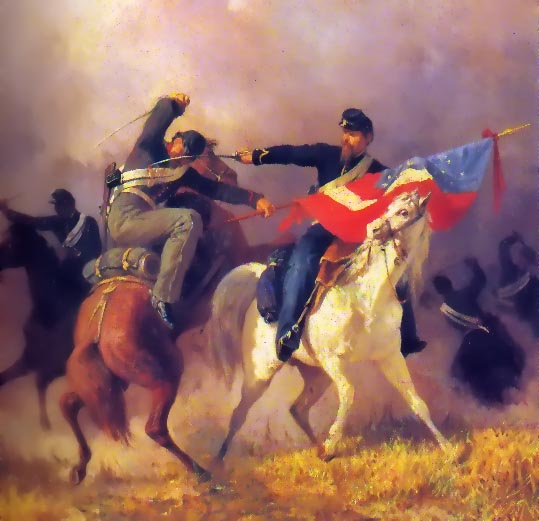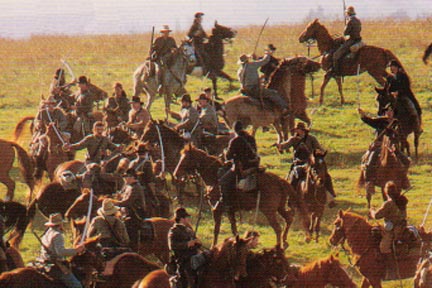|
Civil War History: The Homepage of Civil War Cavalry
This site is dedicated to the history of Civil War mounted units. Its purpose is to foster education and knowledge about the Civil War Period. It features the 1st Connecticut Volunteer Cavalry, Co. A, the 7th Virgina Cavalry, Co. A, and Chew's Battery of Horse Artillery. All of these are active reenacting units that portray both mounted and dismounted cavalry from the Civil War period at shows and events and in war games.
HORSEMEN OF THE CIVIL WAR ERA
A Comparision
Besides mounted Officers, the Cavalry and the Horse Artillery were the only soldiers to regularly ride into battle. Once on the battlefield the artillery dismounted, unlimbered their guns and fought afoot.In sharp contrast to the role played by cavalry during the Napoleonic era, when a well-timed cavalry charge could exploit an infantry breakthrough, overrun the enemy's retreating foot soldiers, and convert a temporary advantage into a complete battlefield triumph, Federal cavalry initially served largely as scouts and escorts. At the Battle of Antietam--the single bloodiest day of the entire war--the Union cavalry suffered exactly 5 men killed and 23 wounded. Nonetheless, Civil War cavalrymen (first the south and then the north) became adept at raiding. Supply lines, railroads, and even supply depots behind the opponent's lines became targets.
Initially the South had a decided advantage when it came to the mounted arm. Southern men from early childhood were accustomed to an outdoor life riding almost everywhere, and their well-bred horses were the best in the world. The elite cavalry units of the Confederate army attracted many of the sons of the planter aristocracy who would rather serve in the saddle as a private than lead men afoot as an officer. Southern horsemen were highly individualistic and fiercely independent. General J.E.B. Stuart rode around the Army of the Potomac three times. Generals like Nathan Bedford Forrest and John S. Mosby created havoc in the west and in the border states.
The Federal mounted forces were at first swept from the field by the better mounted and more skilled Southern riders. Northern troopers, former storekeepers and office workers, had grown away from the rigorous life, but they were tolerant of more discipline and capable of concerted action. Southern raider kept many times their number in Federal horsemen busy in the chase. Skirmishing became the forte of the Federal cavalry (as on the first day of Gettysburg). Southern cavalry rarely fought dismounted in the early years of the war, because they could generally drive their opponents from the field. However, as Federal cavalry became more expert at fighting mounted the advantage of mounted combat for the South decreased, and the Confederate horsemen fought more and more on foot. With time and training the Union cavalry became the match of that of the Confederacy.
At the Battle of Brandy Station, the largest mounted conflict in the western hemisphere, the Federal cavalry with its vast organization was fully the equal of that of the South. Some historians note that at Trevilian Station in 1864, the largest "all cavalry" battle of the war, the northern and southern horsemen fought each other to a standstill. However, large portions of both forces were dismounted. Both the 7th Virginia and the 1st Connecticut were in the battle at Trevilian Station.
During the 1864 Valley Campaign the 7th VA was part of the Laurel Brigade, and the 1st Connecticut was part of Custer's Brigade. They were in almost constant opposition through much of the war.
Chew's Battery was organized by Roger P. Chew and worked closely with the 7th VA during the 1862 Valley Campaign as part of Stuart's Horse Artillery. It was equiped with 20 pound mountain howitzers that could be moved quickly with as few as two horses.
Mounted reenacting isn't for everyone! It is a family activity for those who love history.
You do not have to ride to fully participate.
You are visitor     
Use Left Margin to Navigate
|
 CLICK ON THE IMAGE ABOVE TO GO BACK
CLICK ON THE IMAGE ABOVE TO GO BACK
Dedicated to the Civil War Mounted Arm
The Reenactment at Brandy Station, VA

THE 1ST CONNECTICUT VOLUNTEER CAVALRY REENACTMENT UNIT IS LOCATED IN NORWALK, CT.
THE SEVENTH VIRGINIA CAVALRY REENACTMENT UNIT IS LOCATED IN WOODBRIDGE, NJ.
CHEW'S BATTERY OF HORSE ARTILLERY SUPPORTS THE 7TH VA CAVALRY AT MAJOR REENACTMENT EVENTS AND FIELDS AS THE 3RD NEW HAMPSHIRE ARTILLERY WHEN PORTRAYING A FEDERAL UNIT.
|





 CLICK ON THE IMAGE ABOVE TO GO BACK
CLICK ON THE IMAGE ABOVE TO GO BACK